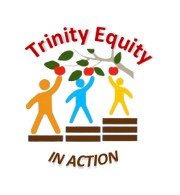

COUNTY
EQUITY
PLAN
Equity recognizes that individuals and groups have different histories and circumstances, and therefore they have unique needs and unequal starting points. Using an equity approach, individuals and groups receive tailored resources, opportunities, support, or treatment based on their specific needs to achieve fair outcomes.
California Department of Public Health
CDPH

Trinity County Equity Strategic Plan Now Available!
A plan addressing health equity challenges impacting communities within Trinity County.
PHASES OF THE PLAN
PHASE 1:
Initiate and Strategize
- Establish a vision, roadmap, and core strategies for communication and community engagement
PHASE 5:
Establish Steering Committee
- Identify a diverse body of constituents to facilitate the equity plan development process including oversight over direction, resourcing, and methods
PHASE 2:
Engage Stakeholders
- Identify and engage community stakeholders through focus groups, surveys, and interviews
PHASE 6:
Develop Community Equity Plan
- Re-engage community stakeholders in the development of the Community Health Equity Action Plan informed by core equity assessment findings and priorities
PHASE 3:
Collect and Analyze Data
(Equity Assessment)
- Assess quantitative and qualitative data to identify health equity trends, challenges, and opportunities
PHASE 7:
Disseminate Community Health Equity Plan
PHASE 4:
Document and Communicate Equity Assessment Findings
- Present Equity Assessment to BOS and community members


WHAT IS "EQUITY"?
While the terms “equity” and “health equity” are increasingly being used, a common understanding of what they mean seems to be lacking. For the purposes of this report, we use the health equity definition from a 2017 Robert Wood Johnson Foundation report, defining health equity as:
"Health equity means that everyone has a fair and just opportunity to be as healthy as possible. This requires removing obstacles to health such as poverty, discrimination, and their consequences, including powerlessness and lack of access to good jobs with fair pay, quality education and housing, safe environments, and health care"
ABOUT THE EQUITY PLAN
Health equity does not occur by accident. It requires an intentional exploration of the forces that limit it and the systems and structures necessary to achieve it. Embedded within this definition is a recognition that individual and community needs will differ depending on the structural, environmental, and historical barriers in place.
The County Equity Plan aims to identify and address the most urgent health, social and equity concerns. The plan will inform the forces that shape the equity landscape within Trinity County, and guide a collective effort to improve Health Equity for all Trinity County residents.
GET INVOLVED
We want to hear from you! We value your perspective, and it helps inform this work. Here are ways to make your voice heard:
Share comments and reflections about the Equity Assessment in the comment box below!
Reach out to us!
Use the contact information below to get connected to upcoming meetings and public comment opportunities.
Want to offer comments or feedback that you feel should be considered during the equity planning process? Complete the form below!
Messages sent to the TrinityEquity inbox will be received by the Trinity Equity in Action Team. Please include your name and contact information so that someone from Trinity Equity in Action can connect with you regarding upcoming opportunities to get involved!


FREQUENTLY ASKED QUESTIONS
What is health equity?
Health equity refers to efforts to ensure that all people have full and equal access to opportunities that enable them to lead healthy lives. (CA Health and Safety Code Section 131019.5)
What are the determinants of equity?
Determinants of equity are defined as the social, economic, geographic, political, and physical environmental conditions that lead to the creation of a fair and just society
What are vulnerable places?
Vulnerable places are places or communities with inequities in the social, economic, educational, or physical environment or environmental health and that have insufficient resources or capacity to protect and promote the health and well-being of their residents. (CA Health and Safety Code Section 131019.5)
What determines your health?
At every stage of life, health is determined by complex interactions between social and economic factors, the physical environment and individual behavior. These factors are referred to as 'determinants of health'.
What are the social determinants of health?
The World Health Organization (WHO) defines the social determinants of health as the conditions in which people are born, grow, live, work and age. These circumstances are shaped by the distribution of money, power and resources at global, national and local levels.
Why is it so important to address health inequities?
Inequities in health status are quite literally a matter of life and death, shown by differences in death rates and life expectancy among the state’s most vulnerable populations. Similar gaps among population groups exist for numerous chronic health conditions that drive the disparities in death rates. Beyond the moral case for addressing inequity, there is also a strong economic argument. Reducing health inequities will yield savings in health care costs. A study in 2011 estimated that more than 30 percent of direct medical costs faced by African Americans, Hispanics, and Asian Americans were excess costs due to health inequities – more than $230 billion over a three-year period, plus indirect costs of $1 trillion in lower workplace productivity due to associated illness and premature death. That three-year total of “excess costs” due to health disparities is equal to approximately half the total of all U.S. health care spending.